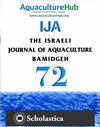模糊模型在冷冻温度下整个黑鲈货架期确定中的应用
IF 0.5
4区 农林科学
Q4 FISHERIES
引用次数: 0
摘要
在本研究中,通过模糊建模来确定整个鲈鱼在冰箱温度(4°C)下的微生物变质情况。保存12 d,观察中温需氧细菌总数(TMAB)、嗜冷需氧细菌总数(TPAB)、乳酸菌总数(LAB)、假单胞菌总数和肠杆菌科细菌总数。采用质量指数法(QIM)对样品进行感官分析,根据感官劣化程度确定保质期。贮藏结束时,微生物的生长有统计学意义(p<0.05)。全鲈鱼在冷藏条件下贮藏第8 d后QI评分差异有统计学意义(p < 0.05)。在模糊逻辑应用中,共确定了12条规则。模糊建模采用Mamdani作为模糊类型,去模糊化方法采用质心。利用三角隶属函数计算模糊隶属值。根据研究结果,确定海鲈鱼的保质期为12天起8天。结果表明,根据冷藏条件下鲈鱼的微生物学参数,应用模糊逻辑可以确定其感官评分(r2 =0.96)。在此背景下,本文认为模糊逻辑可以用于海产品的保质期估算。本文章由计算机程序翻译,如有差异,请以英文原文为准。
Application of fuzzy model for the shelf-life determination of whole sea bass (Dicentrarchus labrax) under refrigerated temperatures
In this study, microbiological deterioration of whole sea bass stored at refrigerator temperatures (4°C) was determined through fuzzy modeling. Total Mesophilic Aerobic Bacteria (TMAB), Total Psychrophilic Aerobic Bacteria (TPAB), Lactic Acid Bacteria (LAB), Pseudomonas sp ., and Enterobacteriaceae counts were observed during 12 days of storage. Quality Index Method (QIM) was used for sensory analysis of the samples and shelf life was determined according to sensory deterioration. The growth of the microorganisms was statistically significant (p<0.05) at the end of the storage period. Additionally, significant differences (p<0.05) were observed for QI scores after the 8 th day of the storage in whole sea bass stored under refrigerated conditions. A total of 12 rules were determined in the fuzzy logic application. Mamdani was used as the fuzzy type for fuzzy modeling, and centroid was used as the defuzzification method. Fuzzy membership values were computed using triangular membership functions. According to the research results, the shelf life of sea bass fish was determined as 8 days from the time of 12 days storage. As a result, it was observed that the sensory score could be determined by using Fuzzy logic (R 2 =0.96) according to microbiological parameters in sea bass stored in refrigerator conditions. In this context, it was concluded that Fuzzy logic could be used in shelf-life estimation in seafood products.
求助全文
通过发布文献求助,成功后即可免费获取论文全文。
去求助
来源期刊
CiteScore
0.90
自引率
16.70%
发文量
49
审稿时长
3 months
期刊介绍:
Information not localized

 求助内容:
求助内容: 应助结果提醒方式:
应助结果提醒方式:


